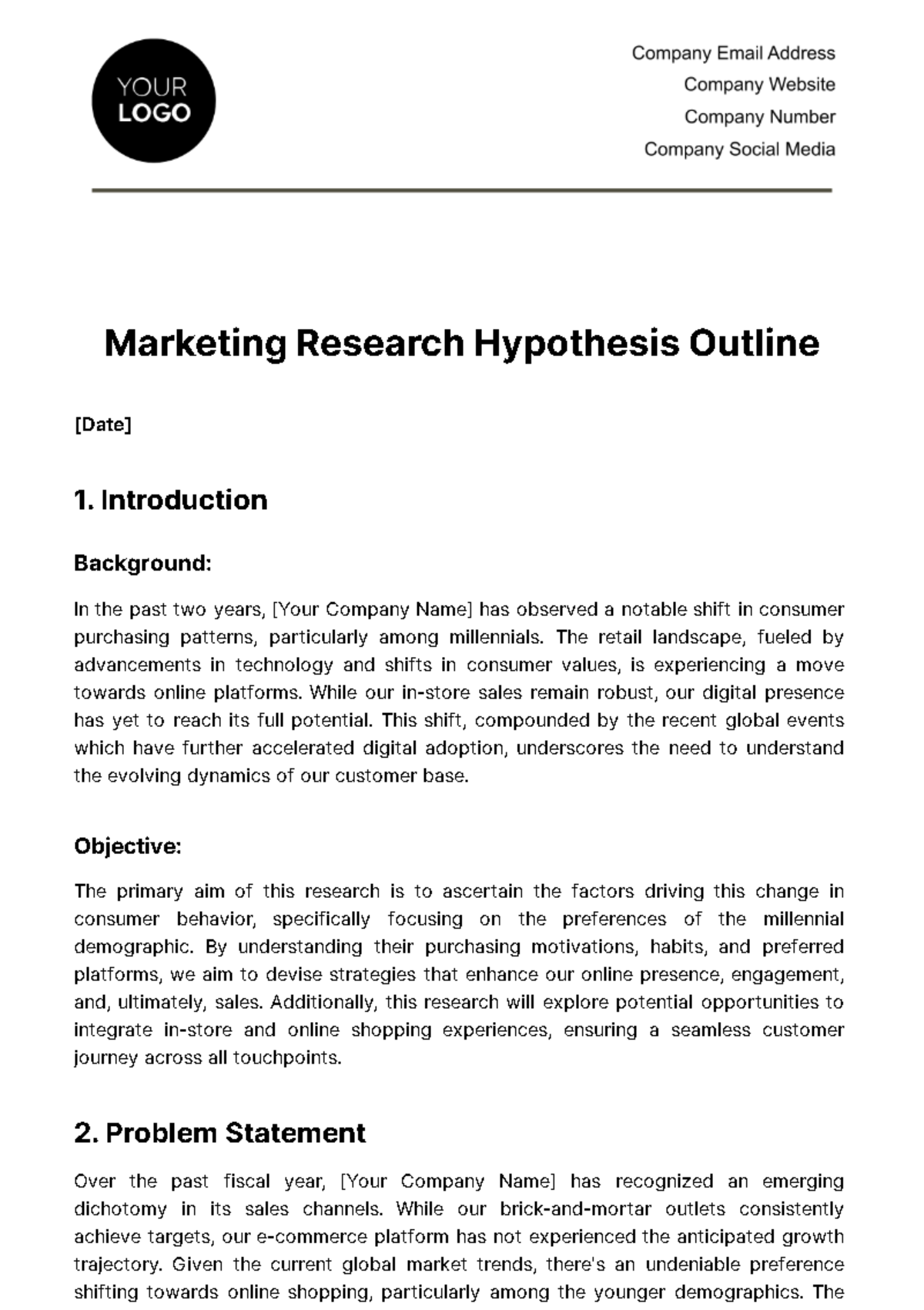Marketing Research Hypothesis Outline
[Date]
1. Introduction
Background:
In the past two years, [Your Company Name] has observed a notable shift in consumer purchasing patterns, particularly among millennials. The retail landscape, fueled by advancements in technology and shifts in consumer values, is experiencing a move towards online platforms. While our in-store sales remain robust, our digital presence has yet to reach its full potential. This shift, compounded by the recent global events which have further accelerated digital adoption, underscores the need to understand the evolving dynamics of our customer base.
Objective:
The primary aim of this research is to ascertain the factors driving this change in consumer behavior, specifically focusing on the preferences of the millennial demographic. By understanding their purchasing motivations, habits, and preferred platforms, we aim to devise strategies that enhance our online presence, engagement, and, ultimately, sales. Additionally, this research will explore potential opportunities to integrate in-store and online shopping experiences, ensuring a seamless customer journey across all touchpoints.
2. Problem Statement
Over the past fiscal year, [Your Company Name] has recognized an emerging dichotomy in its sales channels. While our brick-and-mortar outlets consistently achieve targets, our e-commerce platform has not experienced the anticipated growth trajectory. Given the current global market trends, there's an undeniable preference shifting towards online shopping, particularly among the younger demographics. The challenge at hand is our inability to effectively capture and cater to this burgeoning online consumer base. Despite having a robust digital platform and various online marketing initiatives in place, the expected conversion rates and digital sales figures remain elusive. This gap presents both a pressing challenge and a vast opportunity. Addressing this will not only ensure that we remain competitive in the current landscape but will also position us to harness future market evolutions.
3. Research Hypotheses
In light of the observed market trends and the challenges faced by [Your Company Name], we've formulated the following hypotheses to guide our research:
Hypothesis 1: We postulate that the predominant preference of customers in the age bracket of 18-25 leans towards online shopping rather than traditional in-store purchases. Their digital inclination might stem from a blend of convenience, familiarity with technology, and the vast array of choices available online.
Hypothesis 2: Drawing from recent upticks in engagement during limited-time sales, we hypothesize that promotional offers, such as discounts or loyalty rewards, can amplify customer engagement rates by approximately 20%. These incentives might act as catalysts, encouraging both purchase behaviors and brand interactions.
These hypotheses, while preliminary, serve as directional markers for our research, providing clear objectives against which we can test and validate our observations.
4. Variable
In our quest to understand the evolving consumer behaviors, we'll be relying on a structured approach that measures specific outcomes influenced by certain factors. Our Dependent Variables include the metrics that signify the impact of our strategies: chiefly, the customer engagement rate and sales volume. These quantifiable outcomes will be our primary yardsticks to assess the success or shortcomings of our initiatives. On the other hand, our Independent Variables represent the various elements we will tweak or introduce in our experiment. This encompasses the different types of promotional offers we might roll out, such as discounts, bundled deals, or loyalty programs, as well as the advertising mediums we employ, whether that be social media campaigns, email marketing, or traditional advertising channels. By analyzing the interplay between these variables, we aim to discern patterns and causative factors that can inform our marketing strategies moving forward.
5. Assumptions
As we embark on this research journey, certain foundational beliefs underpin our hypotheses. A primary assumption is that the intrinsic buying patterns of our customers have remained largely consistent over the past year. While external factors, like promotional offers or advertising mediums, might influence purchasing decisions, the core behaviors and preferences of our consumers, we believe, haven't undergone drastic shifts. This assumption is pivotal, as it provides a stable baseline against which we can measure the effects of our varied marketing interventions.
6. Testing Methodology
To rigorously test our hypotheses and ensure accurate results, we've adopted a multi-pronged research approach. Firstly, surveys will be disseminated to a broad spectrum of our consumer base, garnering quantitative data on purchasing preferences and behaviors. In addition, focus groups will be convened to delve deeper into qualitative insights, understanding the motivations and reservations of our customers. For real-time feedback on our online initiatives, we'll employ A/B testing, juxtaposing different promotional strategies to discern which resonates more with our digital audience. This comprehensive methodology aims to provide a holistic understanding, allowing us to make informed decisions moving forward.
7. Expected Outcomes
Upon the completion of our research and hypothesis testing, we anticipate a clearer understanding of our consumer's preferences and behaviors. Specifically, we expect to discern the efficacy of promotional offers in driving engagement and the dominant shopping preferences of the 18-25 age bracket. These outcomes will not only validate or challenge our initial beliefs but will also pave the way for more targeted and efficient marketing strategies in the future.
8. Limitations & Constraints
In conducting our research, we acknowledge potential challenges. These include the limited sample size, which may not wholly represent our diverse consumer base, and potential biases in self-reported data from surveys. Furthermore, rapidly changing market dynamics and external events could influence consumer behavior during our research period, possibly skewing results. Recognizing these constraints is vital for interpreting our findings with caution and precision.
9. Conclusion
In closing, this research aims to delve deep into the evolving consumer preferences and behaviors impacting [Your Company Name]'s market presence. Through methodical hypothesis testing and analysis, we aspire to refine our marketing strategies, ultimately fostering stronger customer relationships and bolstering our brand's position in the competitive landscape.
10. Contact & Further Information
For further inquiries or additional details on the research, please reach out to:
Contact Person: [Your Name]
Marketing Templates @ Template.net






























